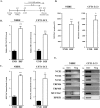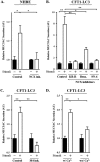Sodium channel TRPM4 and sodium/calcium exchangers (NCX) cooperate in the control of Ca2+-induced mucin secretion from goblet cells
- PMID: 30482841
- PMCID: PMC6341386
- DOI: 10.1074/jbc.RA117.000848
Sodium channel TRPM4 and sodium/calcium exchangers (NCX) cooperate in the control of Ca2+-induced mucin secretion from goblet cells
Abstract
Regulated mucin secretion is essential for the formation of the mucus layer that protects the underlying epithelial cells from foreign particles. Alterations in the quantity or quality of secreted mucins are therefore detrimental to airway and colon physiology. Based on various biochemical assays in several human cell lines, we report here that Na+/Ca2+ exchanger 2 (NCX2) works in conjunction with transient receptor potential cation channel subfamily M member 4 (TRPM4), and perhaps TRPM5, Na+ channels to control Ca2+-mediated secretion of both mucin 2 (MUC2) and MUC5AC from HT29-18N2 colonic cancer cells. Differentiated normal bronchial epithelial (NHBE) cells and tracheal cells from patients with cystic fibrosis (CFT1-LC3) expressed only TRPM4 and all three isoforms of NCXs. Blocking the activity of TRPM4 or NCX proteins abrogated MUC5AC secretion from NHBE and CFT1-LC3 cells. Altogether, our findings reveal that NCX and TRPM4/TRPM5 are both required for mucin secretion. We therefore propose that these two proteins could be potential pharmacological targets to control mucus-related pathologies such as cystic fibrosis.
Keywords: MUC2; MUC5AC; TRPM4; TRPM5; cystic fibrosis; goblet cell; mucin; secretion; sodium-calcium exchange; transient receptor potential channels (TRP channels).
© 2019 by The American Society for Biochemistry and Molecular Biology, Inc.
Conflict of interest statement
The authors declare that they have no conflicts of interest with the contents of this article
Figures





Similar articles
-
TRPM5-mediated calcium uptake regulates mucin secretion from human colon goblet cells.Elife. 2013 May 28;2:e00658. doi: 10.7554/eLife.00658. Elife. 2013. PMID: 23741618 Free PMC article.
-
Pic Protein From Enteroaggregative E. coli Induces Different Mechanisms for Its Dual Activity as a Mucus Secretagogue and a Mucinase.Front Immunol. 2020 Nov 17;11:564953. doi: 10.3389/fimmu.2020.564953. eCollection 2020. Front Immunol. 2020. PMID: 33281812 Free PMC article.
-
Zinc Deficiency Disturbs Mucin Expression, O-Glycosylation and Secretion by Intestinal Goblet Cells.Int J Mol Sci. 2020 Aug 26;21(17):6149. doi: 10.3390/ijms21176149. Int J Mol Sci. 2020. PMID: 32858966 Free PMC article.
-
Mucins, Mucus, and Goblet Cells.Chest. 2018 Jul;154(1):169-176. doi: 10.1016/j.chest.2017.11.008. Epub 2017 Nov 21. Chest. 2018. PMID: 29170036 Review.
-
Secreted Mucins on the Ocular Surface.Invest Ophthalmol Vis Sci. 2018 Nov 1;59(14):DES151-DES156. doi: 10.1167/iovs.17-23623. Invest Ophthalmol Vis Sci. 2018. PMID: 30481820 Review.
Cited by
-
TRP Channels as Cellular Targets of Particulate Matter.Int J Mol Sci. 2021 Mar 9;22(5):2783. doi: 10.3390/ijms22052783. Int J Mol Sci. 2021. PMID: 33803491 Free PMC article. Review.
-
TRPM4 in Cancer-A New Potential Drug Target.Biomolecules. 2021 Feb 5;11(2):229. doi: 10.3390/biom11020229. Biomolecules. 2021. PMID: 33562811 Free PMC article. Review.
-
A TRiP Through the Roles of Transient Receptor Potential Cation Channels in Type 2 Upper Airway Inflammation.Curr Allergy Asthma Rep. 2021 Mar 18;21(3):20. doi: 10.1007/s11882-020-00981-x. Curr Allergy Asthma Rep. 2021. PMID: 33738577 Free PMC article. Review.
-
Pharmacological Modulation and (Patho)Physiological Roles of TRPM4 Channel-Part 2: TRPM4 in Health and Disease.Pharmaceuticals (Basel). 2021 Dec 28;15(1):40. doi: 10.3390/ph15010040. Pharmaceuticals (Basel). 2021. PMID: 35056097 Free PMC article. Review.
-
Hydrogen Sulfide-Evoked Intracellular Ca2+ Signals in Primary Cultures of Metastatic Colorectal Cancer Cells.Cancers (Basel). 2020 Nov 11;12(11):3338. doi: 10.3390/cancers12113338. Cancers (Basel). 2020. PMID: 33187307 Free PMC article.
References
Publication types
MeSH terms
Substances
LinkOut - more resources
Full Text Sources
Miscellaneous

